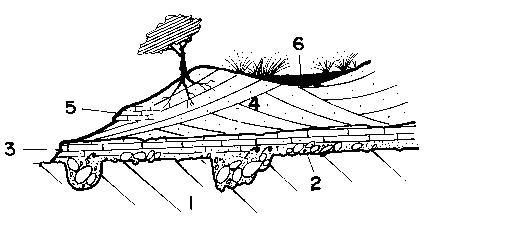The campus lies on an old marine platform cut by wave action at a time when the sea level was higher than at present (15 million years ago). Three rock types may be encountered on campus. The oldest is a hard grey-white quartzite, known as Table Mountain Quartzite (TMQ), which crops out in several road cuttings. Layers of calcrete, old “beachrock” and dune sand overlie the TMQ. The calcrete is a fine-grained, creamy coloured rock that forms the substrate along the trail. It is formed when groundwater dissolves shell fragments in the sand, which is then precipitated as layers of calcrete. (Note: only the dune sand and calcrete horizons are exposed on the trail). Modern dune deposits occur throughout the area. Most common in the reserve are transverse dunes, with crestlines oriented at about 90 ° to the prevailing winds, which blow from the southwest and east. Also present are parabolic dunes, which form parallel to the prevailing winds. Their shape is influenced in part by vegetation patterns.
The dunefield is about 6000 years old, and forms part of a headland bypass dunefield, which once replenished Algoa Bay beaches with sand by overland wind transport. Following the artificial stabilisation of the dunefield in 1870, the headland bypass system was fixed by plant growth and is now largely inactive.
The Geology of an area is very important because it directly shapes plant communities. The plants, in turn, determine what types of animals can survive in the area. As the name "Dune Fynbos" implies, much of the trail lies on an old dunefield.

|
Number |
Strata |
Information |
|
1. |
Fractured Table Mountain Group quartzite (TMQ) |
The oldest rock type encountered on the trail. The Table Mountain Group was formed about 600 MYA. It is full of cracks and joints, making it permeable and a good source of ground water. |
|
2. |
Old wave-cut platform cut into the TMQ |
The wave cut platform originated during the Pleistocene, when sea levels fluctuated to the rhythm of the Northern hemisphere glaciations. The platform is full of potholes and gullies which have been filled with more recent sediments. |
|
3. |
Old Beach rock |
Beach rock is made of the sediments which filled the potholes in the platform, as well as sediments which built up during times of low sea level. Sandy limestone is characteristic of this type of rock and often has sea shells embedded in it. |
|
4. |
Partly Vegetated Sand Dune |
The sand dunes are formed by the prevailing winds blowing sand from the Cape Recife beach over the rocky cape and depositing it in the bay. This forms what is called a headland bypass dunefield. Stabilization (natural and artificial) has impeded this flow of sand. |
|
5. |
Calcrete horizons |
Calcrete is formed when the shells in the sand are slowly dissolved by ground water. Shell fragments make up about 30% of the sand by volume, and thus provide ample raw material. Changes in the soil chemistry cause the dissolved calcium carbonate leached from the shells to be precipitated in the form of calcrete. This fine, cream coloured sediment also appears to form actively around the roots of some plants. |
|
6. |
Modern soil horizon |
This is the "newest" soil in the area and is formed by the buildup of humus and the underlying sandy soil. |